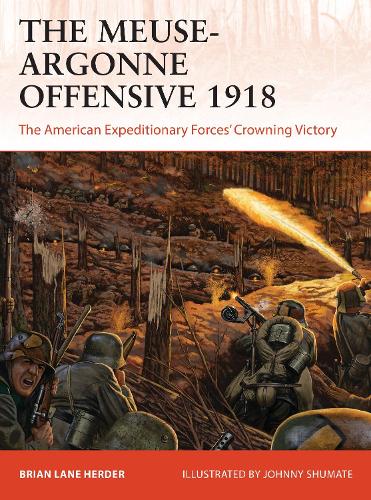
The Meuse-Argonne Offensive 1918: The American Expeditionary Forces' Crowning Victory
(Paperback)
Publishing Details
The Meuse-Argonne Offensive 1918: The American Expeditionary Forces' Crowning Victory
By (Author) Brian Lane Herder
Illustrated by Johnny Shumate
Bloomsbury Publishing PLC
Osprey Publishing
2nd February 2021
10th December 2020
United Kingdom
Classifications
General
Non Fiction
Military history
Warfare and defence
940.436
Physical Properties
Paperback
96
Width 184mm, Height 246mm, Spine 6mm
320g
Description
When the United States declared war on Germany in April 1917, the tiny US Army did not even have a standing division. A huge national army worthy of the Western Front was quickly enlisted, trained, and then transported to France to fight against the Germans. In September 1918, the American Expeditionary Force, under General John Pershing, began its first full-scale offensive against German forces in Lorraine, in which the US First Army and (eventually) the US Second Army would drive north between the Argonne Forest and the Meuse river towards Sedan. The Meuse-Argonne was excellent defensive terrain, being hilly, steep, heavily wooded, and fortified by the Germans over a three-year period. The offensive began on 26 September, 1918. A largely inexperienced US First Army, with mid-level officers including Harry S. Truman, Douglas MacArthur and George Patton, suffered setbacks and heavy casualties during its straight-ahead offensive against a still-potent but fading German Fifth Army. However, by early November, 1.2 million Americans and several hundred thousand French were engaged at the Meuse-Argonne and the Hindenburg Line had been decisively broken. The German withdrawal from Sedan approached a rout and the Americans finally had the Germans on the run until the Armistice ended the offensive on 11 November, 1918. This engaging title tells the full story of this key offensive, illustrating and explaining the troops, weapons and tactics of both the American Expeditionary Force and the German Fifth Army in stunning detail.
Author Bio
Brian Lane Herder graduated with a BA in History from the University of Kansas in 2003, and a Masters of Library Science from Emporia State University in 2009. He is a legislative librarian for the Kansas state government and his historical research interests include the US military, naval warfare, and World War II. Johnny Shumate works as a freelance illustrator. He began his career in 1987 after graduating from Austin Peay State University. Most of his work is rendered in Adobe Photoshop using a Cintiq monitor. His greatest influences are Angus McBride, Don Troiani, and douard Detaille. He lives in Nashville, Tennessee.
